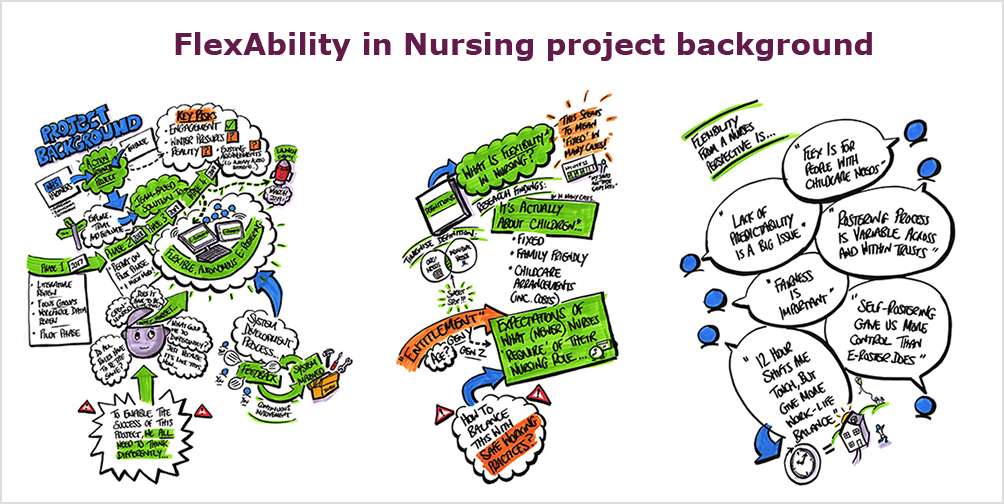

 By Amy Butterworth, Principal Consultant, Timewise
By Amy Butterworth, Principal Consultant, Timewise
It’s just over a year since we launched our Retail Pioneers programme, supported by the Joseph Rowntree Foundation and endorsed by the British Retail Consortium. An innovative piece of action research, it focused on embedding flexibility into store management roles, to create a pathway for progression for retail team members who need to work in this way.
Now, as the programme draws to a close, we’ve written a report setting out what we and the pioneers have learned, which we hope will help steer other organisations in the right direction.
The programme was carried out in partnership with five pioneer retailers: B&Q, COOK, Dixons Carphone, Tesco and The John Lewis Partnership, led by our team of flexible working specialists. We began by bringing them together to discuss the issues they were facing, share their insights and challenge each other’s assumptions and assertions. We then worked with them individually, using our experience to help them understand what their data was telling them and explore potential routes for change.
The feedback we’ve had from the pioneers has been universally positive. It’s clear that the programme was immensely useful, helping them get to grips with the issues they knew about and highlighting others that they didn’t know they had, as well as developing practical, personalised solutions. Or, in the words of Alison Payne, Cook’s Head of People Operations:
“Working with Timewise on the Retail Pioneers programme has given us a rich understanding of the business case for flexibility in our stores, and the potential benefits for our people and our organisation.”
Whilst the programme revealed some recurring themes which were common to all of the retailers, it also underlined the importance of developing bespoke solutions for each one. All their business models are different and so their requirements are too; when it comes to flexible working, it’s clear that there is no one-size-fits-all solution.
As a result, the five pioneers are exploring a range of actions tailored to their particular organisation. From Tesco’s piloting of a team-based approach to flexible job design, to Cook’s creation of a bank of flexible and part-time job descriptions, each one is rooted in the needs of their business and their workforce.
As for us, we believe this is just a starting point. We’re keen to see more retailers, and other sectors, taking a similar approach to delivering flexible roles at management level, and my colleague Emma Stewart is calling on government to invest in making it happen. We’ll keep you posted.
You can read more about the approach each of the pioneers is taking in the full report.
If you would like to take part in a similar programme, or find out more about our flexible audit service, please call 020 7633 4444 or email info@timewise.co.uk
Published April 2018
 We’re now at a particularly exciting point in our FlexAbility in Nursing project, a piece of action research into how flexible working could bring about the change the profession needs.
We’re now at a particularly exciting point in our FlexAbility in Nursing project, a piece of action research into how flexible working could bring about the change the profession needs.
Having explored the issues with the existing system, and subsequently identified team-based rostering as the preferred approach, we’re now part-way through the pilot stage. Our team have been working with over 100 staff across three wards at Birmingham Women & Children’s Hospital to build their first rosters.
Team-based rostering has already been shown to work in a number of similar sectors, such as social care, but the need to have a fully staffed ward at all times required a bespoke approach for nursing.
We have therefore designed a new way of creating each roster, using a ‘lead team’ on each ward, each of whom represents a group of colleagues. The lead team members are responsible for liaising with their colleagues to populate a draft roster, based on individual preferences and requirements, and then collaborating with them further to negotiate an agreed version.
Our aim was that the new system would create much higher engagement from individual team members, and that has proved to be the case. Personal communication about work-life needs and preferences is more adaptable than the previous system of requests being input into a ‘system’ each month.
The feedback we’ve received so far is that individual nurses feel empowered by their ability to get involved, and are taking more responsibility for managing any changes. For example, one ward manager told us:
“I got a text this week saying ‘I need to change my shift, but don’t worry, I’ve already done it.’ Before, this request would have come through to me to sort out; instead, the nurse has worked with her team to find a solution. That’s a great result.”
The pilot has also indicated that the nursing staff see team-based rostering as a fairer system which gives everyone a chance to have some flexibility in their schedules, rather than just those on formal flexible working arrangements (FWAs) which are often only granted to those with childcare responsibilities.
For example, one junior sister explained that, under the previous system, she ended up taking on a disproportionate amount of unpopular shifts, because she didn’t have any specific caring responsibilities or a FWA.
The new system has created an understanding that everyone has to take their fair share of the less popular shifts, and that other responsibilities and preferences (such as being a Brownie leader, taking care of one’s own health, or attending a weekly class) are equally valid.
A third major benefit of the new system is that people have grasped how complicated it is to put a nursing roster together. As a result of working as a team to find the best solution, the nurses now appreciate the effort required to account for all the skills mixes and working requests, and are more prepared to be flexible themselves.
However, as we expected, the pilot has also highlighted some challenges which we need to address as we move forward to the next stage. These include:
In most cases, the lead team members didn’t have any previous experience in leading 1:1 conversations, and were unsure about how to discuss work-life balance and working preferences. Some felt they just needed to write down the shifts people wanted rather than having a dialogue. Others weren’t sure how to handle talking to their colleagues about their personal circumstances.
As a result, we’ve been spending individual time with lead team members who need support to develop these skills, and role playing conversations they can have as they negotiate their next roster.
There were real differences in the length of time that lead team members took to create the draft roster, ranging from 30 minutes to three hours.
This time will reduce as the nurses become more proficient at using the roster technology, but for the future pilots, we plan to incorporate additional training on the most efficient way to create a roster, prior to the first ones being built.
For some groups, such as clinical support workers, who work in small teams which don’t tend to overlap, it was difficult for lead team members to get face to face time with their colleagues to discuss their preferences.
For the purposes of the first pilot, this was tackled using technology such as WhatsApp, and by fitting in meetings just before or just after their shifts. However, we will talk to the team about alternative ways to manage this issue before the next stage.
Some of the participants took a while to understand the collective nature of team-based rostering – that is, it isn’t just about what you want, but about working as a team for the best overall outcome.
We’ve tackled this by making sure we restate the principles throughout the process, and working particularly closely with individuals who are more resistant to change.
The pilot runs until June, and will cover the creation of four rosters for our three wards. We will continue to measure the impact of the new system, using a range of data, and to assess and refine our approach. We will then make final recommendations for a second round of pilots at Nottingham University Hospital and University Hospital Southampton, which are due to start in the summer.
We’re delighted with the progress that we’re making, and the lessons we’re learning from this project; we can already see the potential for building a fairer, more sustainable system that will help tackle the shortages in the nursing sector. We’ll continue to share our findings with you at every stage.
To find out more about the innovative research opportunities we offer, contact info@timewise.co.uk or call 020 7633 4444.
Published March 2018
 In 2016, as part of a revaluation of their working practices, Westminster City Council decided to remodel their City Hall base. Their aim was to make it a better working space for their own staff, and to make part of it available to rent, as a way of generating extra income.
In 2016, as part of a revaluation of their working practices, Westminster City Council decided to remodel their City Hall base. Their aim was to make it a better working space for their own staff, and to make part of it available to rent, as a way of generating extra income.
From a practical point of view, this required them to reduce their desk-to-person ratio, by encouraging more employees to work flexibly. But the team at Westminster quickly realised that they needed to tackle their workplace culture if flexible working was to be successful. So, having spoken to their colleagues at Camden, who had been on a similar journey to become the first accredited Timewise Council, they contacted us for support.
As Aruj Haider, OD Advisor for Westminster explains, “We soon worked out that the office move was an opportunity to transform the way we work. We wanted to find the best way to build flexible working into our strategy, and knew we’d do a better job if we had some expert advice.”
The Timewise programme lasts around four months, and aims to help the council create a flexible working improvement plan, through which they not only become more flexible themselves, but also use their experience to influence other local employers.
The team at Westminster were keen to get input from across their organisation, so they set up an agile working group that was led by John Quinn, Executive Director of Corporate Services, and had representatives from different departments, who were tasked with getting involved. And critically, the programme also involved engaging the top team. As John explains:
“We knew if we were going to make flexible working a success, we’d need to ensure that any culture change was implemented across the board. The leadership workshops were particularly valuable as they’ve made sure that the focus on flexible job design starts right at the top.”
So what has changed at Westminster since they started the programme? The answer is, a great deal.
Today, ‘agile working’ (the term they use internally) is at the heart of their strategy. They’ve developed a clear leadership vision around it that encourages trust and focuses performance management on outcomes, not inputs. They’ve created principles and protocols so that everyone is clear about what agile working involves, and developed an agile working hub where everything agile sits together, including a tech toolkit to support staff who are out there doing it.
And that’s just a snapshot; the change is being led from the top but is cascading down through the council at every level.
But the team know that this isn’t the end – it’s just the beginning. As Aruj points out:
“Understanding the issues around flexible working and culture isn’t a quick fix. We need to make sure everyone in our organisation remains clear about the benefits of working flexibly, so they are aware of, and take advantage of it; it’s a case of repeat repeat repeat.
“Flexible hiring is obviously critical, so we need to continue our work in this area too. We’ve already created resources to support flexible hiring, and are planning a workshop on flexible job design for our HR leaders. “This is all part of our drive to ensure that Westminster is a fair, inclusive and diverse place to work”.
So, what advice does John have for other councils or organisations who are considering a similar move? “Start as early as you can. It does take time to change mindsets and it’s worth making sure you don’t have to rush the process.
“My other piece of advice would be to get some expert help; Timewise’s support has been invaluable. They have helped us to think differently about how to make jobs truly flexible, got the senior team really engaged and have brought the concept of flexible working to life in a way that helps everyone buy into it. I’d definitely recommend the accreditation programme for councils.”
To find out more about becoming a Timewise Council or the other ways that Timewise could support your organisation, please call 020 7633 4432 or email info@timewise.co.uk
Published March 2018
 The introduction of the Apprenticeship Levy in April 2017 made developing apprenticeship schemes a priority for businesses. But although the number of people taking part in these schemes has increased, there are many groups – particularly women, people with caring responsibilities, people with disabilities and young people leaving the care system – who remain shut out. Why? Because most apprenticeships are full-time.
The introduction of the Apprenticeship Levy in April 2017 made developing apprenticeship schemes a priority for businesses. But although the number of people taking part in these schemes has increased, there are many groups – particularly women, people with caring responsibilities, people with disabilities and young people leaving the care system – who remain shut out. Why? Because most apprenticeships are full-time.
So if, as a society, we want to make these opportunities available to all – and if businesses want to increase their chances of hitting their government quotas – developing part-time and flexible apprenticeships is the obvious solution.
That’s why we’ve been working with the Young Women’s Trust, Trust for London and the Learning and Work Institute to investigate how to make apprenticeships an option for people who can’t work full time. We’ve been talking to employers to find out what the barriers and opportunities are, and how we can work together to design roles which are achievable on a part-time basis. And our project partners have had similar conversations with training providers and learners.
Our research has shown, as we suspected, that there are currently very few part-time apprenticeships available; less than one in 10 are contracted for less than 30 hours per week. But it has also shown that it is possible to make them work. So, as is the Timewise way, having worked out what the problem is, we’re now setting out to fix it.
We’re therefore going to be running a new pilot to develop and test models for part-time and flexible apprenticeships. It will be designed and delivered through our Innovation Unit, in partnership with a group of public and private employers, and will start later this year.
Our aim is to deliver innovative solutions that will open up access to skills, better pay and career progression for the millions who need to fit both earning and learning with other life needs. By doing so, we’ll able to help businesses use part-time and flexible apprenticeship models to create more diverse workplaces, reduce gender inequalities and tackle skills shortages.
If you’d like to find out more, or talk to us about how we can be similarly innovative in your own sector, please contact me on info@timewise.co.uk
Published March 2018

By Karen Mattison, Co-Founder, Timewise
Over the past five years, the Timewise Power List has told the stories of 250 individuals who are working flexibly at a senior level. And, while we have been delighted to shine a light on these flexible successes, we have also been aware of the part played by the best flexible employers in making them possible.
Moreover, as a social enterprise, we want to do more than just highlight individual examples of good practice. Underpinning everything we do is our desire to bring about widespread, systemic change, which will help grow the flexible jobs market and unlock more roles to part-time and flexible working. For this to happen, businesses across the board will need to change their approach to both the way they hire, and the way their roles are designed.
So with this in mind, as part of the 2018 Timewise Power 50 awards, we decided to celebrate employers who are taking the lead in making flexible working the new normal. We asked for nominations in the two critical areas of flexible hiring and flexible job design. And our expert judging panel chose two fantastic trailblazers as our winners: Lloyds Banking Group and the Ministry of Defence.
At Lloyds Banking Group (LBG), flexibility isn’t just considered; it’s expected. Following the introduction of their ‘agile hiring initiative’, LBG has moved from the assumption that most jobs are full-time to the assertion that part-time and flexible work can be possible and, in some cases, can even be preferable.
Critically, hiring managers are now expected to include an option for agile working in any roles they advertise, and explain their rationale for any that don’t. As a result, around 90% of LBG vacancies are promoted as agile (against a national average of 12%) and around 43% of employees work in an agile way.
And as LBG’s Fiona Cannon explains, this isn’t just good news for the Group, or even for their employees; the benefits of having flexible hiring as the default position are wider-reaching than that. “This initiative is helping us build a fairer, more representative workforce where employees are able to thrive, which sits at the heart of our ambition to help Britain prosper.”
A similarly innovative approach is being taken by the Ministry of Defence (MoD). The Regular Armed Forces are contracted to be available 365 days a year, which makes developing a part-time working policy a huge challenge. However, the MoD are keen to keep pace with the increased demand for part-time and flexible working, and so have launched a two year Flexible Duties Trial.
The trial will investigate how flexible job design could allow serving personnel to ‘dial down’ their level of commitment for a limited period, within a longer service career. Their aim is to keep hold of talented, experienced personnel and support recruitment of the next generation.
By looking at a seemingly insurmountable problem in a creative way, the MOD stand a good chance of making this traditional workplace future fit. As Group Captain Clive Montellier explains: “This trial is challenging the entrenched expectations of the workforce, and so getting the job design right is absolutely critical.”
Our winning employers are setting examples which, if others follow, could radically change the flexible jobs market.
If flexible working becomes the default hiring position across the board, more people who want or need it will be able to keep working, and progress their careers. And if all jobs are creatively designed to incorporate flexibility, in a way that suits both employers and employees, it won’t take long to become ‘just the way it’s done’.
We’re proud to be showcasing two of the best flexible employers as part of this year’s Power 50, and it’s just the start; we’re hoping to expand our focus in the years ahead. Watch this space.
To find out more about flexible hiring and flexible job design, and the training and consultancy we offer to support their development, please call 020 7633 4444 or email info@timewise.co.uk
Published March 2018
Karen Mattison, Co-Founder
 Following the government’s requirement that employers publish details of their gender pay gap by April 2018, some employers are already on the front foot. Step forward Diageo, the global beverage company and Timewise Partner, who published their report in November 2017. It’s a detailed report, which makes interesting reading for anyone who believes in the drive for better workplace equality.
Following the government’s requirement that employers publish details of their gender pay gap by April 2018, some employers are already on the front foot. Step forward Diageo, the global beverage company and Timewise Partner, who published their report in November 2017. It’s a detailed report, which makes interesting reading for anyone who believes in the drive for better workplace equality.
Firstly, we’re delighted that Diageo have acknowledged that flexible working is central to closing the gender pay gap. Indeed, they have noted that designing jobs to be more flexible is a key part of their solution going forwards, confirming that they “…will continue to partner with Timewise, with whom we run flexible job design workshops… to ensure roles can be delivered flexibly.”
Interestingly, the work we are doing with Diageo isn’t specifically gender focused; as our recent research has revealed, in today’s workplace, flexibility is for everyone. But experience has shown us that if you get flexible working right, you can’t help but narrow your gender pay gap. As the 2016 Women and Equalities Committee Report into the issue stated:
“A large part of the gender pay gap is down to women’s concentration in part-time work which doesn’t make use of their skill…. Old-fashioned approaches to flexibility in the workplace and a lack of support for those wishing to re-enter the labour market are stopping employers from making the most of women’s talent and experience.”
Secondly, as Diageo know, tackling the gender pay gap through flexible working requires a hands-on approach. As they say in their report “We are proactively identifying roles across the business that are particularly suitable for part-time, job share and flexible job design, to help break down barriers for applicants who do not wish to work full-time.”
So if, like Diageo, you’re looking to close your gender pay gap, and agree that flexibility is part of the solution, here are some suggestions:
Our research has shown that almost 9 in 10 of the UK workforce either work flexibly already or wish they could. However, fewer than 1 in 10 jobs are advertised as being flexible, which means these candidates have a limited pool of jobs to apply for.
Diageo have stated up front that they are open to a conversation about how they can make their roles work flexibly, but this is still all too rare. There’s a big opportunity here for progressive employers like them to scoop up talented flex-enthusiasts.
If the people in your organisation don’t approach flexible working positively, it’s doomed to failure. In particular, senior leaders and line managers need to understand the benefits flexibility can bring to the business, and be trained in how to support their flexible employees.
This is something that Diageo is rightly proud of. As Louise Jones, their part-time Head of HR, explains:
“The environment that Diageo fosters and my commitment to the company makes my part-time role achievable. The level of trust is exceptional and it is also normal for employees to flex where they work as and when it makes sense to do so. What matters at Diageo is what you deliver, not where you sit.”
Flexible working is far more likely to succeed when a role is designed flexibly, rather than just having elements of flexibility shoehorned in. However, some organisations still try and take shortcuts, such as expecting a part-time employee to squeeze a full-time job into fewer days.
As Diageo have stated, they take a more proactive approach, working with us to deliver workshops on flexible job design through our training and consultancy service. One of the initiatives they are hoping to implement is an internal job share portal, which will help their employees find a job share partner.
With these kind of well-planned processes in place, organisations will be able to reduce their gender pay gap, not to mention improving career progression for flexible employees and creating a fairer, more inclusive workplace. And with April 2018 looming, there’s no time to waste.
Diageo deliberately invite flexible talent into their organisation, saying: “If you’re looking for a flexible role, come and join us.” We’d like to issue a similar invitation to employers: if you’re looking to tackle your gender pay gap through flexible working, come and talk to us.
To find out more about our consultancy and training services, please call 020 7633 4444 or email info@timewise.co.uk
This article has been written in association with Diageo, one of our Timewise partners. Published February 2018.
 The British Retail Consortium has identified that flexibility is one of the main reasons why people choose to work in retail. But, as retailers are only too aware, the number of people working flexibly at management level is a fraction of those in customer-facing roles.
The British Retail Consortium has identified that flexibility is one of the main reasons why people choose to work in retail. But, as retailers are only too aware, the number of people working flexibly at management level is a fraction of those in customer-facing roles.
So when we asked the retail community whether they would be interested in being part of our Retail Pioneer Programme, we were delighted by the response. Five major retailers immediately spotted the potential value of the programme to their business, of which John Lewis Partnership was the first to sign up. As Lesley Ballantyne, John Lewis Partnership’s Partner Proposition and Experience Director, explains:
“We had seen how the work Timewise had carried out on a previous pilot programme had deepened the retailer’s understanding about how to incorporate flexible working into a retail business. So we took the opportunity to go on our own flexible journey through the Retail Pioneer Programme.
“We had a hunch that the lack of flexible working options at management level was preventing our partners from progressing their careers. So we agreed to focus the programme on making first-line management roles work on a flexible basis, to allow non-managers who need flexibility to move into these roles.”
The first stages of the programme involved looking at the business case for flexibility, and assessing the firm’s capacity for change. We conducted a series of focus groups and a staff survey, with the aim of identifying the level of satisfaction with current flexible provision, the latent demand for flexibility, and whether career progression on a flexible or part-time basis was considered a realistic possibility.
And their insights were revealing to say the least, says Lesley:
“It was really useful to get input from an external agency with specific expertise in flexible working. The resulting research certainly opened our eyes to our partners’ perceptions, as well as challenging our assumptions.
“For example, while we were aware of the impact that general pressures on the retail industry are having on line managers’ workloads, the fact that this would make flexible working feel even less achievable was a barrier we hadn’t anticipated.”
Based on the insights revealed by the research, we recommended several options for implementing flexible working at a first-line management level. And we were delighted when the John Lewis Partnership team opted to pilot a team-based approach to designing and rostering these roles across five of its stores. As Lesley explains:
“Our stores operate on a 60+ hour week, so no one really works ‘full-time’ in a traditional sense. That should make it possible for our first-line managers to decide together how to staff their store, based on the flexibility each one of them needs, rather than have rosters imposed on them.”
And she is hoping that the pilots signal the beginning of a new flexible era for John Lewis Partnership:
“If we can demonstrate that this level of flexibility isn’t just possible, but preferable, and create role models who are doing it successfully, then we’ll be able to incorporate this into our hiring practices too. So, when we have a vacancy, we’ll be able to invite candidates to bring their own flexible preferences into work. That’s a powerful incentive to come and work with us.”
So, what advice would Lesley give to other organisations who would like to develop their own flexible working approach?
“We knew that we couldn’t just wave a magic wand to make flexible working a success, so it has been really helpful to have Timewise supporting us on the journey. Their independent and professional approach applied a laser-like focus to the issue and gave us a much richer insight than we could have achieved alone.
“I’d advise other organisations to be open-minded about the barriers to and effects of flexible working, and to be prepared to have their assumptions challenged; the programme has brought issues to the surface that we previously only had an inkling of. We thoroughly enjoyed working in partnership with the Timewise team and feel that we understand our business better as a result.”
If you would like to know more about our flexible consultancy services, or discuss how you might benefit from working with Timewise, please call 020 7633 4444 or email info@timewise.co.uk
Published January 2018
 As part-time work becomes more widespread, it’s increasingly important that the roles are designed properly. But research published in the journal of Human Relations has indicated that, in many cases, there isn’t a process in place.
As part-time work becomes more widespread, it’s increasingly important that the roles are designed properly. But research published in the journal of Human Relations has indicated that, in many cases, there isn’t a process in place.
One in five professionals and managers in the UK works part-time already, with more than two in five working part-time in the Netherlands. Moreover, there is huge unfulfilled demand for part-time working: a Timewise study shows that a quarter of full-timers in the UK would actually prefer to work less, and earn less.
However when it comes to designing these part-time roles, the employees themselves are often left to get on with it, without input from their employers. Even those who are sympathetic to flexible working in principle rarely take any responsibility for reducing their employees’ outputs to match their reduction in hours.
This failure to think through the requirements of the job means that the part-time professional often ends up delivering 100% of the outputs in 60 or 80% of the hours – and for 60 or 80% of the salary. The result is usually high pressure of work for the part-timer, as well as insufficient time for development, networking or career-building.
And there’s a knock-on effect for other employees too. Seeing the lack of effort to address workload on transition to part-time hours can lead to others being reluctant to request part-time working. They see the stress and unfairness of part-timers having to deliver disproportionately heavy workloads, as well as the negative impacts on their career, and it puts them off following a similar path.
But there is another way: redesign the job collaboratively. Some of the part-time professionals featured in the research negotiated with colleagues, manager and clients to distribute workload more fairly across the team, and to arrange cover during their absence. This ‘crafting’ of the job, in collaboration with colleagues, enabled a more appropriate workload, and predictable time off for part-time professionals, although most only managed to craft their workload and schedule after they had secured a part-time job.
So, employers who want to attract and retain the best talent need to recognise that part-time job design often cannot be done by the individual alone. Job redesign is best done by the team as a whole, with committed support from the wider organisation. If that doesn’t happen, it’s not surprising that part-time professionals often feel stigmatised and see their careers stagnate.
Employers also need to address two common working practices which can stand in the way of successful part-time work. The first is the expectation that the individual, as opposed to the team, will be constantly available to deal with unpredictable client demands. The second is the failure to plan and share the team’s workload collaboratively, so that work is distributed fairly across the team.
It’s clear from the research that the way forward is for employers to redesign the working practices of the whole team, rather than leaving individuals to work out their part-time solutions in isolation. With mounting evidence that more people want to work part-time – not just parents and carers, but also older workers, millennials and those with health issues – employers need to address part-time job design, and adapt working practices to the changing shape of the workforce.
The research was conducted by Dr Charlotte Gascoigne as part of her PhD, and is published with Professor Clare Kelliher from the Cranfield School of Management. The findings were based on in-depth interviews with part-time professionals and managers in both the UK and the Netherlands.
To find out more about the innovative research opportunities we offer, contact info@timewise.co.uk or call 020 7633 4444
Published December 2017
 By Emma Stewart, Co-Founder
By Emma Stewart, Co-Founder
I’ve long been troubled by the fact that the teaching profession appeared to be lagging behind other sectors in their approach to part-time and flexible working. And the constant trickle of headlines highlighting teaching staff shortages has only reinforced my conviction that something needs to be done.
So I was delighted to be invited by Justine Greening MP, the Secretary of State for Education, to attend her department’s recent Flexible Working in Schools summit, and share Timewise’s experience and insights in flexible working, hiring and job design with the panel.
As we know from our research into today’s flexible workforce, a staggering 87% of the UK workforce either works flexibly already, or would like to. And a previous piece of research into women returners highlighted that 58% of those coming back to work after a year or more would prefer a part-time role.
Yet, as figures shared at the summit showed, while 42% of working women in the UK work part-time, only 25% of female teachers do. And given that only 9.7% of primary school jobs and 6.6% of those in secondary schools were advertised as part-time last year, that’s hardly surprising. Other kinds of flexible working, such as compressed or staggered hours appear to be even less common.
It’s clear, then, that there’s a big gap between flexible supply and demand in teaching, and between teaching and other sectors. So the key question is, why? The panel were agreed that the two biggest barriers are a logistical one of timetabling and a more cultural one of mindset. In both cases, having buy-in from senior leadership teams, and role models setting examples, were considered critical to closing the gap.
Certainly, there are pockets of flexible excellence within teaching, and some fantastic role models too. Liz Robinson and Nicola Noble, co-heads at Surrey Square Primary School who attended the summit, are just one example. But as is often the case, they took the initiative to create their arrangement themselves; it wasn’t an advertised role.
Yet, when schools are prepared to hire flexibly, it pays off. TES Global have found that job adverts that mention the words part-time get 13% more interest than those that don’t; given the fierce competition for the best talent, that’s well worth considering. The uplift doesn’t stop once the staff are on board either: research for ACAS by the University of Manchester has found that flexible working increases both personal and team effectiveness. And it has been shown time and again to have a positive effect on retention and motivation of staff in all sectors.
Of course understanding the problem is only half the battle; now we need to fix it. And the good news is, the will to do so starts at the very top. Ms Greening has pledged action from the DfE, including:
It’s important that those working across the profession, from multi-academy trusts and governing bodies to teaching unions, are empowered and supported to take action too.
That means testing new ways to help headteachers design jobs with flexibility built in. It means trialling new approaches to designing part-time and flexible jobs, which still work within the school timetable and maintain quality teaching standards. It means equipping senior leaders to build a business case for part-time and flexible working, and create a culture in which it’s both acceptable and achievable. And it means advertising teaching roles as flexible up front, rather than waiting for staff to ask.
The Flexible Working in Schools summit felt like a watershed moment for the teaching profession – and I was delighted to be part of it. But it’s just the beginning; the hard work starts now.
If you would like to know more about the work we do at Timewise, please call Emma on 020 7633 4444 or email info@timewise.co.uk
Published November 2017
 The staffing crisis in the NHS is in the news more often than any of us would like. From the fact that more nurses are leaving the profession than joining, and the drop in the number of EU nurses registering to work in the UK to the potential impact of British expat pensioners returning home, there’s little doubt that something needs to be done to attract more people into the profession – and to keep the nurses we already have.
The staffing crisis in the NHS is in the news more often than any of us would like. From the fact that more nurses are leaving the profession than joining, and the drop in the number of EU nurses registering to work in the UK to the potential impact of British expat pensioners returning home, there’s little doubt that something needs to be done to attract more people into the profession – and to keep the nurses we already have.
So the time really is right for a root-and-branch look at how nursing works in practice, in terms of workload, scheduling and nurses’ ability to balance work with other responsibilities. Our new FlexAbility in Nursing project, which we’re running in conjunction with three leading hospital trusts (Birmingham Women’s & Children’s Hospital, Nottingham University Hospital and University Hospital Southampton), will deliver exactly that.
The project, which is supported by funding from the Burdett Trust, is a piece of action research into how flexible working could bring about the change the profession needs.
The first stage of the project is now complete. It involved a literature review and a series of focus group sessions, designed to understand how flexible working is defined within the NHS, what the barriers are, and how to overcome them. One of the key learnings to come out of this stage is that flexibility means very different things to different stakeholders.
So, from the employer’s point of view, flexibility is seen as a way to achieve efficiency and save costs – particularly bank and agency costs. In an ideal world, all staff would be ‘fully flexible’, and able to fill rota gaps at short notice, so that the right staff are in the right place at the right time.
But many nurses are coming at it from a different direction. When rotas vary wildly from one week to the next, it’s difficult to plan a life. So for them, flexible working means working within an agreed, predictable framework and, in some cases, working fewer hours. For example, nurses who are parents may want to work fewer shifts a week, and need these to be on the same day and same time each week so they can arrange childcare. Flexibility, for nurses, needs to be fixed.
It’s clear then, that the gap between what employers and employees require from a flexible working solution is a tough one to bridge. And the way it’s organised now isn’t working for anyone.
The current variable rota system doesn’t give many nurses with other responsibilities the fixed working arrangement they need; in the words of one nurse who we spoke to: “If you have kids, you need a partner who’s flexible, or a family who can do care. If you don’t have that, you can’t be a nurse.” Other nurses are equally disillusioned, feeling that they get given an unfair amount of the unsocial hours.
Nor does it give managers enough choice about how to organise their shifts; as one told us: “Once you’ve done the skill mixes and the formal flexible working arrangements, it leaves no choice about who does the other shifts.”

It’s no wonder, given this mismatch of needs, that the profession is struggling to attract and recruit enough staff. So the next step in our programme is to find a new approach that works for everyone: giving nurses the right kind of flexibility to suit their work-life balance needs and keep them in the profession, whilst allowing managers to deliver efficient and effective resourcing. And of course, as a result, encouraging more people to become nurses.
We’ll do this by designing a team based approach to scheduling rotas, and then piloting it. We’re working on the design right now; once it’s finalised we’ll pilot it first with three wards at Birmingham Children’s Hospital early next year. We’ll share our learnings at both stages of the process, so if you’re in the nursing profession – or if it matters to you that the NHS is properly staffed – watch this space.
To find out more about the innovative research opportunities we offer, contact info@timewise.co.uk or call 020 7633 4444
Published November 2017